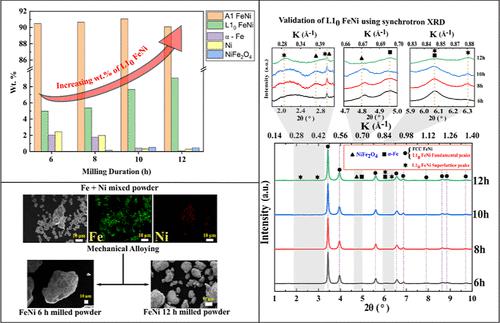Our official English website, www.x-mol.net, welcomes your
feedback! (Note: you will need to create a separate account there.)
Formation of L10 Ordering in FeNi by Mechanical Alloying and Field-Assisted Heat Treatment: Synchrotron XRD Studies
ACS Omega ( IF 3.7 ) Pub Date : 2023-04-10 , DOI: 10.1021/acsomega.2c07869
Shuvam Mandal 1, 2 , Ajit Panigrahi 1, 2 , Ashutosh Rath 1, 2 , Matthias Bönisch 3 , Pradyut Sengupta 1, 4 , Mayadhar Debata 1, 2 , Suddhasatwa Basu 1, 2, 5
ACS Omega ( IF 3.7 ) Pub Date : 2023-04-10 , DOI: 10.1021/acsomega.2c07869
Shuvam Mandal 1, 2 , Ajit Panigrahi 1, 2 , Ashutosh Rath 1, 2 , Matthias Bönisch 3 , Pradyut Sengupta 1, 4 , Mayadhar Debata 1, 2 , Suddhasatwa Basu 1, 2, 5
Affiliation

|
L10-ordered FeNi, tetrataenite, found naturally in meteorites is a predilection for next-generation rare-earth free permanent magnetic materials. However, the synthesis of this phase remains unattainable in an industrially relevant time frame due to the sluggish diffusion of Fe and Ni near the order–disorder temperature (593 K) of L10 FeNi. The present work describes the synthesis of ordered L10 FeNi from elemental Fe and Ni powders by mechanical alloying up to 12 h and subsequent heat treatment at 623 K for 1000 h without a magnetic field and for 4 h in the presence of 1.5 T magnetic field. Also, to address the ambiguity of L10 phase identification caused by the low difference in the X-ray scattering factor of Fe and Ni, synchrotron-based X-ray diffraction is employed, which reveals that 6 h milling is sufficient to induce L10 FeNi formation. Further milling for 12 h is done to achieve a chemically homogeneous powder. The phase fraction of L10-ordered FeNi is quantified to ∼9 wt % for 12 h milled FeNi, which increases to ∼15 wt % after heat treatment. Heat treatment of the milled powder in a magnetic field increases the long-range order parameter (S) from 0.18 to 0.30. Further, the study of magnetic properties reveals a decrease in magnetic saturation and a slight increase in coercivity with the increase in milling duration. At the same time, heat treatment in the magnetic field shows a considerable increase in coercivity.
中文翻译:

通过机械合金化和场辅助热处理在 FeNi 中形成 L10 有序:同步加速器 XRD 研究
L1 0有序的 FeNi,tetrataenite,天然存在于陨石中,是下一代无稀土永磁材料的首选。然而,由于 Fe 和 Ni 在 L1 0 FeNi的有序-无序温度 (593 K) 附近扩散缓慢,该相的合成在工业相关时间框架内仍然无法实现。目前的工作描述了通过机械合金化长达 12 小时,随后在 623 K 下无磁场热处理 1000 小时和在 1.5 T 磁场下热处理 4 小时,从元素 Fe 和 Ni 粉末合成有序 L1 0 FeNi . 另外,为了解决 L1 0的歧义由于 Fe 和 Ni 的 X 射线散射因子的低差异导致的相识别,采用基于同步加速器的 X 射线衍射,这表明 6 小时的研磨足以诱导 L1 0 FeNi 的形成。进一步研磨 12 小时以获得化学均质的粉末。对于 12 小时研磨的 FeNi,L1 0有序 FeNi的相分数被量化为~9 wt%,在热处理后增加到~15 wt%。在磁场中对研磨粉末进行热处理会增加长程有序参数(S) 从 0.18 到 0.30。此外,磁性能研究表明,随着研磨持续时间的增加,磁饱和度降低,矫顽力略有增加。同时,磁场中的热处理显示矫顽力有相当大的增加。
更新日期:2023-04-10
中文翻译:

通过机械合金化和场辅助热处理在 FeNi 中形成 L10 有序:同步加速器 XRD 研究
L1 0有序的 FeNi,tetrataenite,天然存在于陨石中,是下一代无稀土永磁材料的首选。然而,由于 Fe 和 Ni 在 L1 0 FeNi的有序-无序温度 (593 K) 附近扩散缓慢,该相的合成在工业相关时间框架内仍然无法实现。目前的工作描述了通过机械合金化长达 12 小时,随后在 623 K 下无磁场热处理 1000 小时和在 1.5 T 磁场下热处理 4 小时,从元素 Fe 和 Ni 粉末合成有序 L1 0 FeNi . 另外,为了解决 L1 0的歧义由于 Fe 和 Ni 的 X 射线散射因子的低差异导致的相识别,采用基于同步加速器的 X 射线衍射,这表明 6 小时的研磨足以诱导 L1 0 FeNi 的形成。进一步研磨 12 小时以获得化学均质的粉末。对于 12 小时研磨的 FeNi,L1 0有序 FeNi的相分数被量化为~9 wt%,在热处理后增加到~15 wt%。在磁场中对研磨粉末进行热处理会增加长程有序参数(S) 从 0.18 到 0.30。此外,磁性能研究表明,随着研磨持续时间的增加,磁饱和度降低,矫顽力略有增加。同时,磁场中的热处理显示矫顽力有相当大的增加。







































 京公网安备 11010802027423号
京公网安备 11010802027423号